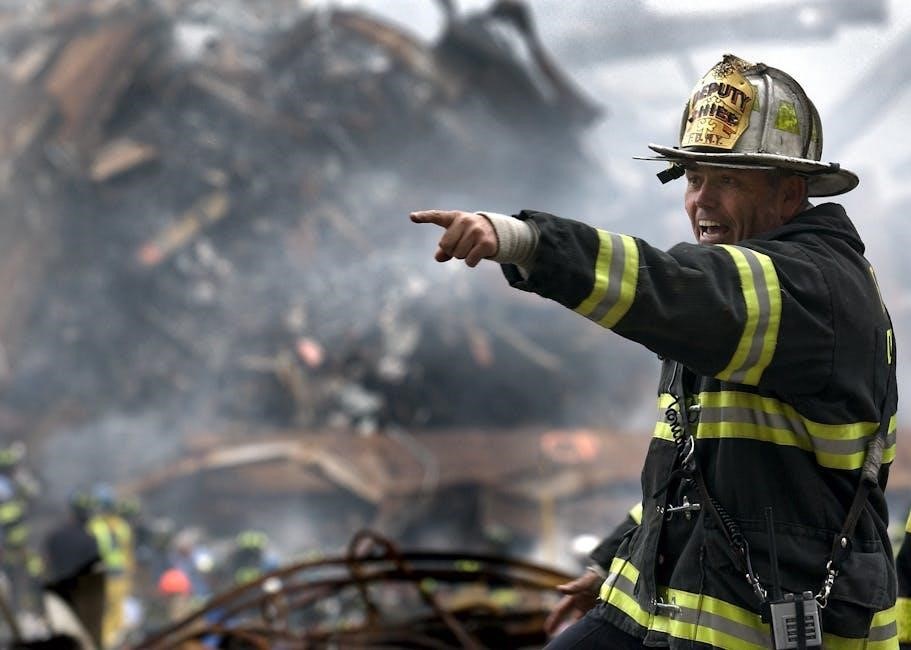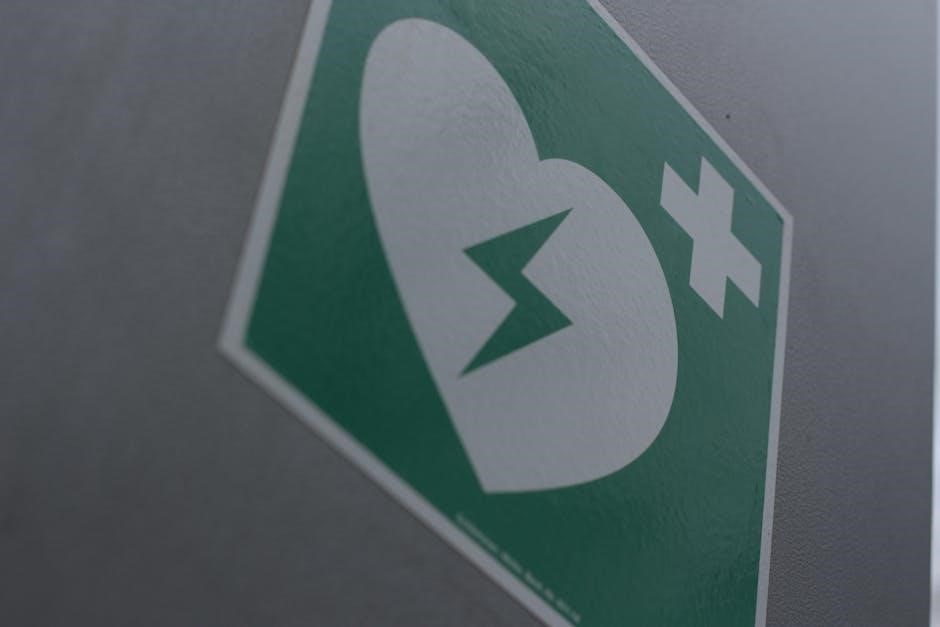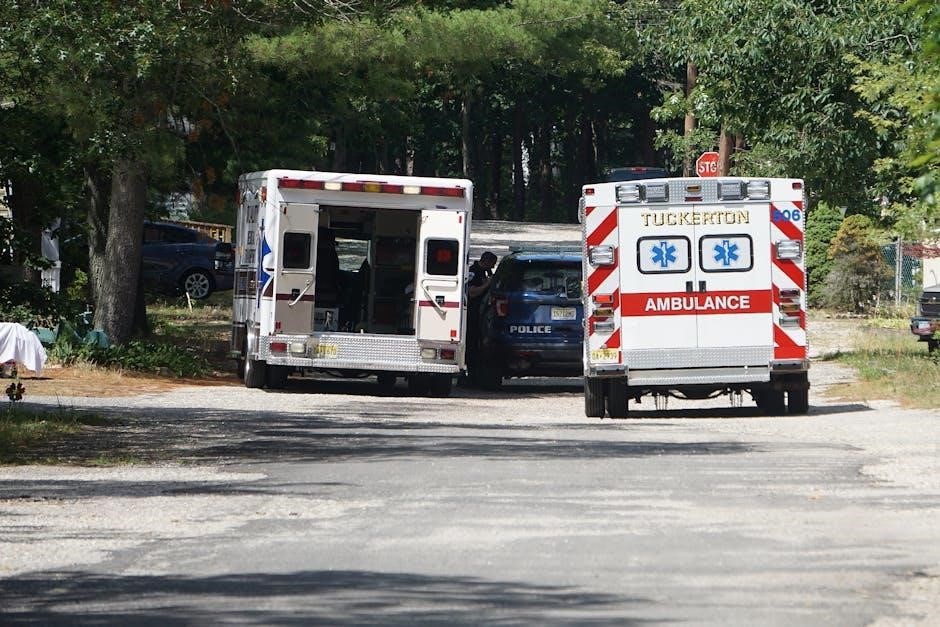The St John First Aid Quiz Questions and Answers PDF is a comprehensive resource designed to help individuals prepare for first aid exams. It includes multiple-choice questions, flashcards, and detailed explanations to enhance learning and retention. This guide covers essential first aid topics, ensuring users are well-equipped to handle various emergencies effectively.
Overview of the Resource
The St John First Aid Quiz Questions and Answers PDF is a concise, 3-page document uploaded in May 2024. It contains multiple-choice questions, flashcards, and detailed explanations to aid exam preparation. Each question includes hints and correct answers, covering essential first aid topics. The resource is ideal for self-study, helping users understand key concepts and apply them in real-life scenarios. It serves as a valuable tool for anyone aiming to excel in the St. John Ambulance First Aid Exam with confidence and competence.
Importance of First Aid Training
First aid training is crucial for empowering individuals to respond confidently in emergencies. It equips people with the skills to prevent injuries from worsening and save lives. Knowledge of proper techniques, such as wound care and CPR, ensures timely and effective assistance. Regular training also reduces panic in high-stress situations, fostering a safer community. The St John First Aid Quiz PDF emphasizes these principles, helping learners master essential practices through interactive questions and real-world scenarios.
Structure of the PDF Guide
The St John First Aid Quiz Questions and Answers PDF is organized into clear sections, featuring multiple-choice questions, flashcards, and detailed explanations. Each question includes hints and correct answers, along with practical scenarios to reinforce learning. The guide covers definitions, key concepts, and real-life applications, ensuring a thorough understanding of first aid principles. With three pages of concise yet comprehensive content, this resource is ideal for exam preparation and quick reference, uploaded in May 2024 for the 2023/2024 study period.

Benefits of Using the St John First Aid Quiz Questions and Answers PDF
The PDF offers an interactive learning experience with multiple-choice questions and flashcards, providing self-assessment opportunities and comprehensive coverage of first aid topics for effective exam preparation.
Enhanced Learning Experience
The St John First Aid Quiz Questions and Answers PDF offers an interactive and engaging way to study. With flashcards, multiple-choice questions, and detailed explanations, learners can test their knowledge and understand concepts deeply. The structured format allows for self-paced learning, making it easier to retain information. This resource also provides hints and explanations, enabling users to identify areas for improvement and master first aid skills effectively. It’s a valuable tool for both beginners and experienced individuals seeking to refine their expertise.
Self-Assessment Opportunities
The St John First Aid Quiz Questions and Answers PDF offers excellent self-assessment opportunities, enabling users to evaluate their knowledge and identify areas for improvement. With flashcards, multiple-choice questions, and detailed explanations, individuals can test their understanding of first aid concepts. This interactive approach allows learners to track their progress, reinforcing retention and confidence. By practicing with real-life scenarios and receiving immediate feedback, users can refine their skills and ensure they are prepared for actual emergencies. This tool is invaluable for both beginners and experienced first aiders seeking to enhance their expertise.
Comprehensive Coverage of First Aid Topics
The St John First Aid Quiz Questions and Answers PDF offers extensive coverage of first aid topics, ensuring a thorough understanding of emergency care. It includes questions on wound care, burns, fractures, and cardiac arrest, providing clear explanations for each scenario. The guide also addresses medical conditions like diabetic emergencies and allergic reactions, along with legal considerations such as Good Samaritan laws.
By covering a wide range of topics, the PDF equips individuals with the knowledge needed to respond confidently in various situations, from minor injuries to life-threatening emergencies.

How to Prepare for the St John First Aid Exam
- Understand the exam format and question types to improve time management.
- Use the St John First Aid Quiz PDF for practice questions and answers.
- Focus on key topics like wound care, burns, and cardiac arrest.
- Employ spaced repetition and flashcards for effective retention of first aid techniques.
Understanding the Exam Format
The St John First Aid Exam typically includes multiple-choice questions and practical scenarios to assess both knowledge and application skills. The PDF guide mirrors this format, offering questions with hints and detailed explanations to aid understanding. It covers a variety of topics, from basic wound care to advanced life-saving techniques, ensuring comprehensive preparation. Familiarizing oneself with the exam structure through this resource helps build confidence and improves problem-solving abilities in real-life first aid situations.
Key Topics to Focus On
Key topics include wound care, burns, fractures, and cardiac arrest. Mastering CPR techniques, the recovery position, and tourniquet use is essential. Understanding how to manage choking, head injuries, and allergic reactions is also critical. Familiarize yourself with the ABCDE approach and secondary surveys. Practice scenarios involving crush injuries, where washing the area with soap and water, seeking medical aid, and safely containing sharp objects are vital. These topics ensure a strong foundation for first aid response.
Effective Study Techniques
Effective study techniques for the St John First Aid exam include active recall, spaced repetition, and practice tests. Use flashcards to memorize key terms and concepts. Dedicate time to review mistakes and understand explanations; Simulate exam conditions by timing yourself and answering questions without hints. Focus on understanding scenarios rather than memorizing answers. Prioritize topics you find challenging and ensure a distraction-free study environment. Consistent practice and review will enhance retention and confidence for the exam.

Common First Aid Scenarios Covered in the Quiz
The quiz addresses scenarios like crush injuries, requiring washing with soap, seeking medical aid, and safely containing sharps for testing, ensuring practical emergency preparedness.
Bleeding and Wound Care
Proper management of bleeding and wound care is critical in first aid. The St John First Aid Quiz emphasizes cleaning wounds with soap and water, applying pressure to control bleeding, and using dressings to prevent infection. For crush injuries, washing the area and seeking medical aid is essential. The guide also highlights safely containing sharp objects for testing, if possible. These techniques ensure effective wound care and promote healing, reducing the risk of complications.
Burns and Scalds
Burns and scalds require immediate attention to prevent further tissue damage. The first step is to cool the affected area with cool water for 10-15 minutes. Remove any clothing or jewelry near the burn, as these can stick to the skin as it swells. Do not apply ice or break blisters, as this can cause infection. For severe burns, seek medical help promptly. The PDF guide provides detailed questions and answers to ensure proper understanding of these critical first aid procedures.
Fractures and Sprains
The St John First Aid Quiz addresses fractures and sprains, emphasizing proper immobilization and care. For fractures, immobilize the affected area with a splint and apply ice to reduce swelling. Seek immediate medical attention. For sprains, follow the RICE method: Rest, Ice, Compression, and Elevation. The PDF provides scenarios and questions to test understanding of these injuries, ensuring learners can apply correct first aid techniques confidently in real-life situations.
Cardiac Arrest and CPR
Cardiac arrest requires immediate intervention. The St John First Aid Quiz emphasizes CPR techniques, including chest compressions and rescue breaths. Questions cover recognition of symptoms, such as unresponsiveness and lack of breathing, and the proper use of automated external defibrillators (AEDs). The PDF guide provides clear explanations and scenarios to help learners master life-saving skills, ensuring they can act confidently in emergencies. Regular practice and understanding of CPR protocols are stressed to improve survival rates.

Specific First Aid Techniques Explained
This section details essential first aid methods, such as the recovery position, tourniquet application, and bandaging. It also covers managing choking and wound care effectively in emergencies.
The Recovery Position
The recovery position is a critical first aid technique used to maintain an unconscious person’s airway. It involves placing the individual on their side, with their top leg bent to prevent rolling. This position helps prevent choking by allowing vomit or fluids to exit the mouth. Properly executed, it ensures the airway remains open, promoting breathing. The recovery position is essential for maintaining victim safety until medical help arrives. It is a fundamental skill covered in the St John First Aid Quiz PDF.
Use of Tourniquets
Tourniquets are critical for controlling severe bleeding from limbs. They should only be applied if direct pressure fails. Place the tourniquet 2-3 inches above the wound, tightening until bleeding stops. Never loosen once applied. Key points: use a wide, sturdy material, avoid improvising with unsuitable items, and seek immediate medical help. Proper training is essential to prevent further harm. This technique is covered in the St John First Aid Quiz PDF, ensuring learners understand its correct application and limitations.
Application of Bandages
Proper bandage application is crucial for wound care. Start by cleaning the wound with soap and water. Select the appropriate bandage type, such as roller or adhesive strips. Wrap securely, ensuring even pressure to promote healing. Avoid tight wrapping to prevent circulation issues. For deep wounds, apply direct pressure and seek medical aid. The St John First Aid Quiz PDF provides detailed steps and scenarios to master bandaging techniques effectively.
Management of Choking
Choking occurs when an object blocks the airway, preventing breathing. Immediate first aid is crucial. For adults and children, the St John guide recommends five back slaps between the shoulder blades. If unsuccessful, abdominal thrusts are performed to dislodge the object. For infants, chest thrusts are used instead of abdominal thrusts. The PDF provides step-by-step instructions and diagrams to ensure proper technique, emphasizing the importance of acting quickly to restore breathing and prevent complications.

First Aid for Specific Injuries
Learn effective first aid for injuries like crush wounds, head injuries, and eye injuries. Wash affected areas with soap and water, seek medical aid, and contain sharps safely if possible.
Head Injuries and Concussions
A head injury or concussion requires immediate attention. Symptoms include headache, dizziness, confusion, or loss of consciousness. First aid involves assessing the situation, ensuring the person is conscious, and controlling bleeding if present. Do not move the individual unless necessary and avoid giving pain medication. Monitor vital signs and seek immediate medical help if symptoms worsen or if there is a loss of consciousness. Proper care can prevent long-term complications.
Eye Injuries
Eye injuries require immediate attention to prevent further damage. The St John First Aid Quiz highlights key steps: flush the eye with clean water, avoid rubbing, and seek medical help. Never apply pressure or remove foreign objects stuck in the eye. Use protective coverings to shield the injury. The PDF provides scenarios and answers to ensure proper handling of chemical splashes, blunt trauma, and other eye-related emergencies, emphasizing the importance of prompt action to preserve vision and prevent complications.
Heat and Cold-Related Injuries
Heat-related injuries, such as heat exhaustion and heat stroke, require immediate cooling measures. Move the person to a cool place, remove excess clothing, and apply cool water. For cold-related injuries like hypothermia or frostbite, gently rewarm the affected area and avoid direct heat. Both conditions demand prompt first aid to prevent severe complications. The PDF guide provides detailed protocols for assessment and treatment, ensuring effective care in such emergencies.
Animal Bites and Stings
Animal bites and stings require immediate attention to prevent infection and promote healing. The St John First Aid Quiz highlights key steps, such as cleaning the wound with soap and water, monitoring for signs of infection, and seeking medical aid if necessary. For stings, removing the stinger and applying a cold compress is essential. The guide also covers specific scenarios, like snake bites, emphasizing immobilization and avoiding tourniquets. Proper wound care and knowledge of when to seek professional help are stressed to ensure effective first aid.

General First Aid Principles
General first aid principles emphasize assessment, prioritization, and safe intervention. They include the primary survey (ABCDE approach), wound cleaning, and dressing to promote healing and prevent infection.
Assessment of the Situation
Assessment is the first step in any first aid response. It involves ensuring personal safety, checking the scene for hazards, and evaluating the casualty’s condition. Stay calm, prioritize safety, and quickly identify potential dangers. Look for visible injuries, unusual behaviors, or signs of distress. Note the number of casualties and any life-threatening conditions. This step ensures effective care and prevents further harm. Proper assessment guides immediate actions and ensures the best outcomes for those in need.
Primary Survey (ABCDE Approach)
The Primary Survey, using the ABCDE approach, is a systematic method to assess a patient’s condition. It starts with ensuring the Airway is clear, followed by checking Breathing for normality. Next, assess Circulation by checking for pulse and bleeding. Then, evaluate Disability through neurological responses. Finally, Expose the patient to identify hidden injuries. This method helps prioritize life-threatening conditions effectively.
Secondary Survey
The secondary survey involves a thorough head-to-toe examination of the patient to identify injuries or conditions not detected during the primary survey. It includes checking for signs of injury, such as swelling, bruising, or deformities, and assessing vital signs. Documentation of findings is crucial for ongoing care. For example, in cases of crush injuries, the secondary survey may reveal internal injuries requiring immediate medical attention. This step ensures comprehensive patient assessment and guides further treatment decisions effectively.
Wound Cleaning and Dressing
Proper wound cleaning and dressing are critical to prevent infection and promote healing. The process involves rinsing the wound with clean water, using mild soap to remove dirt, and gently patting it dry. Applying an antibiotic ointment can help reduce infection risk. Dressing the wound with a sterile bandage protects it from further contamination. Regular monitoring for signs of infection, such as redness or swelling, is essential. Seek medical attention if the wound is deep or contains foreign objects, as professional treatment may be required.

First Aid for Medical Conditions
The PDF covers first aid for diabetic emergencies, epileptic seizures, asthma attacks, and allergic reactions, providing clear steps to manage these conditions effectively in emergency situations.
Diabetic Emergencies
Diabetic emergencies, such as hypoglycemia (low blood sugar) and hyperglycemia (high blood sugar), require immediate attention. Symptoms of hypoglycemia include confusion, shakiness, and sweating, while hyperglycemia may cause excessive thirst and frequent urination. First aid involves administering fast-acting glucose for hypoglycemia and seeking medical help for hyperglycemia. The PDF guide provides detailed questions and answers to help individuals recognize and respond to these conditions effectively, ensuring proper care until medical assistance arrives.
Epileptic Seizures
The St John First Aid Quiz Questions and Answers PDF provides detailed guidance on managing epileptic seizures. It explains how to recognize seizure symptoms, ensure the person’s safety, and provide post-seizure care. The resource includes questions and answers on appropriate first aid techniques, such as clearing the area of hazards and not restraining the individual. It also covers when to seek medical help, ensuring users understand the critical steps to take during and after a seizure.
Asthma Attacks
Asthma attacks require immediate first aid to ease breathing and prevent complications. Recognize symptoms like wheezing, coughing, and shortness of breath. Assist the person to sit upright and remain calm. Help them use their inhaler as directed, and if symptoms worsen, seek medical aid promptly. Ensure the environment is free from triggers and provide reassurance to reduce panic. Knowing these steps is crucial for effective first aid in asthma-related emergencies.
Allergic Reactions
Allergic reactions can range from mild to life-threatening, requiring immediate first aid. Symptoms include hives, swelling, difficulty breathing, and anaphylaxis. Administering epinephrine via an auto-injector is critical in severe cases. The PDF guide provides detailed questions and answers on recognizing signs, proper treatment, and follow-up care. It emphasizes the importance of seeking medical attention after an allergic reaction. Practice questions help reinforce understanding of these critical first aid steps, ensuring preparedness for real-life scenarios.

Legal and Ethical Considerations in First Aid
Understanding legal and ethical principles is crucial in first aid. The PDF guide outlines responsibilities, privacy, and liability, ensuring first responders act within legal boundaries while providing care.
Good Samaritan Laws
Good Samaritan Laws protect individuals who provide first aid in good faith during emergencies. These laws shield first aiders from legal liability, ensuring they act without fear of repercussions. Understanding these laws is crucial, as they encourage bystanders to assist confidently. The St John First Aid Quiz highlights scenarios where these laws apply, emphasizing the importance of acting in good faith and within one’s training. This knowledge empowers individuals to provide timely, effective care without hesitation.
Confidentiality and Privacy
Confidentiality and privacy are critical ethical principles in first aid. First aiders must protect patients’ personal information and medical details, ensuring they are only shared with authorized healthcare professionals. Maintaining confidentiality builds trust and respects individuals’ rights, even in emergency situations. Breaching this principle can lead to legal consequences and damage to professional reputation. Adhering to these standards is essential for upholding ethical practices in first aid care.
Liability Issues
Liability issues in first aid concern the legal risks faced by first responders. Acting in good faith and following proper protocols can minimize liability. Understanding these risks ensures responders provide care responsibly. The St John First Aid Quiz PDF highlights key legal considerations, helping individuals avoid potential legal consequences while administering aid. Proper training and adherence to guidelines are emphasized to reduce liability concerns effectively.
Consent in First Aid Situations
Obtaining consent is crucial before providing first aid to ensure ethical and legal standards are met. The St John First Aid Quiz PDF emphasizes the importance of consent, explaining that it must be informed and voluntary. If a person is conscious and capable, they should agree to treatment. For unconscious individuals, consent is implied; The resource provides scenarios and questions to test understanding of consent principles, ensuring first aiders are prepared to act responsibly and respectfully in emergencies.

Tips for Acing the St John First Aid Exam
Master time management, understand question types, and review mistakes. Stay calm, focus on practical scenarios, and apply knowledge confidently for optimal performance in the exam.
Time Management During the Exam
Effective time management is crucial for success in the St John First Aid Exam. Allocate 1-2 minutes per question to ensure thorough reading and understanding. Start by skimming through the entire exam to gauge the difficulty and prioritize questions you’re confident about. Skip complex questions initially and return to them later. This strategy helps maximize your score and reduces stress. Practice with the PDF to improve both accuracy and speed, ensuring you complete the exam within the allotted time.
Understanding Question Types
The St John First Aid Quiz features multiple-choice questions, true/false statements, and scenario-based queries. Familiarizing yourself with these formats is crucial for exam success. Multiple-choice questions test knowledge recall, while scenario-based ones assess practical application. True/false questions evaluate understanding of key concepts. Reviewing the question types helps in allocating time effectively during the exam, ensuring you answer confidently and accurately. This variety prepares you for real-life first aid situations, enhancing your problem-solving skills and decision-making abilities.
Reviewing Mistakes
Reviewing mistakes is crucial for improving first aid knowledge and exam performance. The St John First Aid Quiz PDF provides detailed explanations for incorrect answers, helping users understand where they went wrong. By identifying error patterns, individuals can focus on weak areas and reinforce their understanding of critical first aid concepts. This reflective process ensures better retention and confidence, making it an essential step in effective exam preparation and real-world application of first aid skills.
Staying Calm and Focused
Staying calm and focused is crucial during the St John First Aid exam. Deep breathing exercises and positive visualization can help manage nerves. Practicing mindfulness techniques beforehand ensures a clear mind, allowing for better concentration and decision-making during the test.
The St John First Aid Quiz Questions and Answers PDF helps familiarize users with exam formats, reducing anxiety. Regular practice builds confidence, enabling individuals to approach questions methodically and remain composed under time constraints.
The St John First Aid Quiz Questions and Answers PDF is an invaluable tool for mastering first aid skills, ensuring confidence and preparedness in emergencies. Use it wisely.
Final Thoughts on the Importance of First Aid Training
First aid training is crucial for equipping individuals with life-saving skills. The St John First Aid Quiz Questions and Answers PDF serves as an invaluable tool, offering structured learning and practical insights. By mastering these resources, learners can confidently respond to emergencies, reducing risks and improving outcomes. Regular practice and application of knowledge are essential for maintaining proficiency. Encouraging others to pursue first aid training fosters a safer, more prepared community.
Encouragement to Practice and Apply Knowledge
Consistent practice and real-world application of first aid skills are crucial for building confidence and competence. Regularly reviewing the St John First Aid Quiz Questions and Answers PDF ensures readiness in emergencies. Applying knowledge through practical exercises and simulations reinforces learning, making it easier to act decisively when needed. Encourage others to join in training sessions to create a safer community. Remember, first aid is not just a skill—it’s a lifeline.